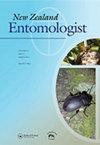一种误入歧途的针头千足虫:来自英国新西兰的一种新的多足目千足虫和1920年在新西兰的细足虫属(多足目:细足虫科)
IF 0.4
4区 农林科学
Q4 ENTOMOLOGY
引用次数: 1
摘要
摘要:千足虫是一种行动缓慢的土壤生物,不容易分散到新的栖息地。然而,物种可以由人类远距离运输,并在植物园和温室等人类栖息地找到。因此,一些千足虫物种已经从世界各地引入欧洲。在这里,我们描述了三种新的尖头千足虫(Polyzoniida):来自英国的dudleycookeorum sp.nov.与新西兰的标本有密切的亲缘关系,以及来自新西兰Tawhiti Rahi(Poor Knights Islands)的coxaespinosus sp.nov和obtus sp.nv。Siphonthus dudleycookeorum sp.nov.最初在英国的Lamorran House Gardens(康沃尔)发现,通过DNA条形码和与新西兰节肢动物收藏馆(NZAC)的标本进行比较,可以追溯到新西兰。由于1895年库克虹吸管科的属和种特征研究得很差,1920年将新物种放在新西兰唯一的虹吸管属中是暂时的。根据可用的材料和S.bellus Chamberlin(1920)和S.enotatus Chamberling(1920)的正模照片,我们认为目前被归类为Siphonesus的物种至少属于两个独立的属。可以预见,新西兰蕴藏着大量未描述的多足虫和千足虫,因为各种藏品中都有许多未分类的标本,而且相对较小的岛屿Tawhiti Rahi的材料已经产生了两个新的科学物种。http://www.zoobank.org/urn:lsid:zoobank.org:pub:6D3FF76F-16A2-43ED-B9CC-F34B4EBE7525http://www.zoobank.org/urn:lsid:zoobank.org:act:F59D9647-6F25-448F-AD36-DE9F86F187D6http://www.zoobank.org/urn:lsid:zoobank.org:act:A0718515-C5AE-4BE1-B32A-312FB66E9B5Chttp://www.zoobank.org/urn:lsid:zoobank.org:act:3D4D8C0C-F30E-42B9-8CBD-E394C635FD87本文章由计算机程序翻译,如有差异,请以英文原文为准。
A pinhead millipede astray: a new polyzoniidan millipede from New Zealand in Great Britain and the genus Siphonethus Chamberlin, 1920 in New Zealand (Polyzoniida: Siphonotidae)
ABSTRACT Millipedes are slow-moving soil organisms, which do not easily disperse to new habitats. However, species can be transported by humans across large distances and be found in anthropogenic habitats like botanical gardens and glasshouses. Thus, several millipede species have been introduced from around the world to Europe. Here we describe three new species of pinhead millipedes (Polyzoniida): Siphonethus dudleycookeorum sp. nov. from Great Britain with close affinities to specimens from New Zealand, and Siphonethus coxaespinosus sp. nov. and Siphonethus obtusus sp. nov. from Tawhiti Rahi (Poor Knights Islands) from New Zealand. Siphonethus dudleycookeorum sp. nov. was initially discovered in Lamorran House Gardens (Cornwall) in Great Britain and could be traced back to New Zealand with DNA-barcoding and comparison to specimens from the New Zealand Arthropod Collection (NZAC). As generic as well as species characters of the Siphonotidae Cook, 1895 are only poorly worked out, the placement of the new species in the only New Zealand genus Siphonethus Chamberlin, 1920 is provisional. Based on the available material and photographs of the holotypes of S. bellus Chamberlin, 1920 and S. enotatus Chamberlin, 1920, we suggest that the species currently classified as Siphonethus belong to at least two separate genera. It can be expected that New Zealand harbours a great diversity of undescribed polyzoniidan millipedes, as a lot of unsorted specimens are present in various collections and already material from the relatively small island Tawhiti Rahi has yielded two species new to science. http://www.zoobank.org/urn:lsid:zoobank.org:pub:6D3FF76F-16A2-43ED-B9CC-F34B4EBE7525 http://www.zoobank.org/urn:lsid:zoobank.org:act:F59D9647-6F25-448F-AD36-DE9F86F187D6 http://www.zoobank.org/urn:lsid:zoobank.org:act:A0718515-C5AE-4BE1-B32A-312FB66E9B5C http://www.zoobank.org/urn:lsid:zoobank.org:act:3D4D8C0C-F30E-42B9-8CBD-E394C635FD87
求助全文
通过发布文献求助,成功后即可免费获取论文全文。
去求助
来源期刊

New Zealand Entomologist
ENTOMOLOGY-
CiteScore
0.70
自引率
33.30%
发文量
3
审稿时长
>12 weeks
期刊介绍:
The invertebrate diversity of New Zealand is of great interest worldwide because of its geographic isolation and geological history. The New Zealand Entomologist plays an important role in disseminating information on field-based, experimental, and theoretical research.
The New Zealand Entomologist publishes original research papers, review papers and short communications. We welcome submissions in all aspects of science regarding insects and arthropods in a New Zealand or Australasian setting. The journal’s subject matter encompasses taxonomy, phylogenetics, biogeography, biological control and pest management, conservation, ecology and natural history.
The journal is the official publication of the Entomological Society of New Zealand. Papers published or submitted elsewhere for publication will not be considered, but publication of an abstract or summary elsewhere (e.g. conference proceedings) does not preclude full publication in the New Zealand Entomologist. Accepted papers become copyright of the Entomological Society of New Zealand. The journal is published in English, but we also welcome publication of abstracts in Maori.
 求助内容:
求助内容: 应助结果提醒方式:
应助结果提醒方式:


